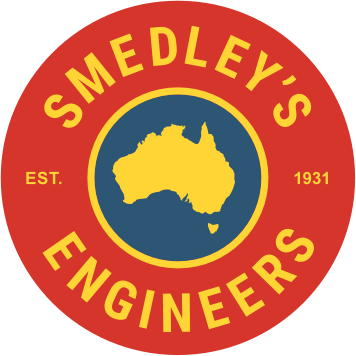The NHVR released an almost national level notice for Tier 1 network access:
Since the inception of Performance Based Standards (PBS), industry and operators have been frustrated with the need to apply/be approved for Tier 1 vehicle or combination mass vehicle approval, as well as being required to apply to each state and council for permission to use their roads at Tier 1 approved masses.
The objective of the National Class 2 Tier 1 PBS Notice:
The objective of the National Class 2 Tier 1 PBS Notice (Tier 1 PBS Notice) is to give operators of PBS vehicles immediate access to relevant PBS networks across Australia. This will give the industry a level of assurance of being able to operate immediately when a Vehicle Approval (VA) is issued, although, in many cases, at a restricted mass.
To achieve this, NHVR has proposed a baseline notice that is acceptable to all jurisdictions with capped network masses, and vehicle lengths, with minimal unique jurisdictional conditions. Under this notice, this approach will provide a high percentage of the PBS fleet with access and promote cross border travel on approved networks.
This notice authorises access to specified networks for eligible Performance Based Standards (PBS) vehicles that hold a Vehicle Approval, allowing them to operate if they meet the requirements of Tier 1 General Access or Restricted Access, as mentioned under Part A4 of the Standards and Vehicle Assessment Rules, and are in compliance with the other conditions of this notice.
Summary –
Quick summary of what is included:
Level 1 Tier 1 20m B-Doubles (2-2)
Level 1 Tier 1 20m B-Doubles (3-2)
Level 2 Tier 1 26m A-Doubles (2-2-2 & 3-2-3)
Level 2 Tier 1 30m A-Doubles (3-2-3 & 3-3-3)
Quick summary of what is not included:
Level 1 Tier 1 20m Quad Singles (4)
Level 2 Tier 1 20m Split Tri (1-2)
Level 2 Tier 1 20m Split Quads (1-3)
Level 2 Tier 1 30m B-Double (3-4) & (4-4)
While the above combinations are not included in the new Tier 1 notice, they can still be used after a permit is applied for and approved from the NHVR.
No Change to Truck and Dog Notice
While the current truck and dogs in operation under PBS all come with both Tier 1 and Tier 3 masses, the Heavy Vehicle National Law – National Class 2 PBS Level 1 & 2A Truck and Dog Trailer Authorisation Notice 2021 (No.1) is still a valid document and it is recommended that T&D operators continue to operate under the above notice rather than looking at the new Tier 1 Gazette.
—————
What is Tier 1?
Tier 1 is the lowest assessment level of a three (3) tier bridge assessment formula being used by bridge and structural engineers to conduct basic and more involved assessments of bridge structures.

Bridge Access:
The following methods or tier assessments will determine the limitations/impact on PBS vehicles. Note that each successive tier may allow greater gross mass and may reduce the extent of network access.
Tier 1 – General Access or Restricted Access
Must meet the bridge formulae listed in Bridge Formula (Tier 1) [see below]
Tier 2 – Special Access
Must not cause greater effects than those caused by existing commercial vehicles, that are acceptable to the bridge owner.
Tier 3 – Specific Link Access
Approval by the owners of the bridges to use all the bridges on a specific link based on detailed individual bridge assessment.
*Any combination that uses quad axles will automatically be subjected to a Tier 3 assessment.
Bridge Formulae (Tier 1)
The minimum distance, L (metres), between the extreme axles of any two axle groups – for a given total gross mass, M (tonnes), on the axles within that distance – is controlled by the relevant bridge formula for a given total gross mass, M (tonnes), on the axles within that distance – is controlled by the relevant bridge formula.
The absolute minimum internal distance allowed between any two axle groups is 2.5 m.
For vehicles operating under the Concessional Mass Limits scheme, axle groups are to be treated as though they are laden to General Mass Limits. Higher Mass Limits vehicles will only have access to portions of the road and bridge network that the jurisdiction considers to be suitable for Higher Mass Limits vehicles.
Access to the PBS Level 1 road network
Mass = 3L + 12.5 for Mass less than 42.5t and Mass = L + 32.5 for M >= 42.5 t
Access to the PBS Level 2 road network
M = 3L + 12.5 for M <= 46.5 t and M =1.5L + 29.5 for M >= 46.5 t
Access to the PBS Level 3 and Level 4 road networks
M = 3L + 12.5 for all M
Networks and Mass Caps
Apart from some changes in South Australia, the proposed network mass caps have been accepted in all jurisdictions.
NHVR proposed network mass caps:
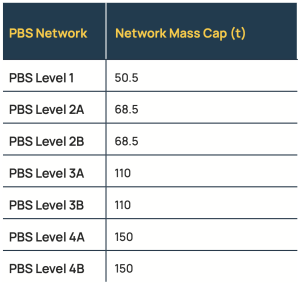
The notice will point to the networks which will be displayed on a jurisdiction’s website. The notice will display the mass caps for each network.
Networks, vehicle length & conditions that will be displayed for publication:
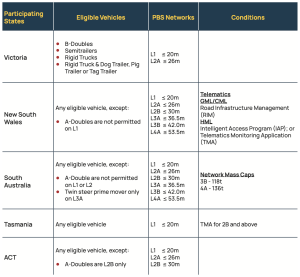
The NHVR conducted a desktop assessment overlaying jurisdictional prescriptive networks over their relevant PBS networks, realising that the PBS networks were limited in comparison. There are opportunities to grow the PBS networks, especially when imposing network caps to include the prescriptive networks. For example, 30m PBS A-double, and all lesser PBS combinations, should get access to the state-controlled roads in the type 1 road train routes.
Jurisdictional Network Conditions
Where an eligible vehicle operates at HML, it must only operate on the approved HML roads of a network in the following jurisdictions: TAS, QLD, NSW, ACT
South Australia
- All PBS A-doubles to access the PBS Level 3A network only.
- A height cap of 4.6m
- The mass caps in South Australia will differ on the PBS Level 3B and 4A networks.
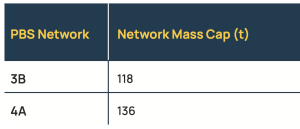
Vehicle Lengths
For the purposes of the Tier 1 PBS Notice, the maximum vehicle lengths from the PBS Network Classification Guidelines will be utilised as shown in table 3. This requirement was a unanimous jurisdictional proposal that was accepted by NHVR.
For jurisdictions that wish to approve access for vehicles that exceed the maximum lengths of the PBS Network Classification Guidelines, the National Class 2 Higher Productivity PBS Notice will accommodate that functionality.
Eligible Vehicles
The NHVR believes all combinations complying with the PBS standards, with a tier 1 mass nomination in their vehicle approval, should be eligible under this notice.
However, some jurisdictions have requested that certain vehicle types or combinations be excluded from access under this notice and continue to require a permit to access the relevant roads or networks.
Nationally excluded vehicles
- Vehicles with specific ADR exemptions for additional axle groups will be excluded.
- Vehicles with tri-axle drive groups.
- Vehicles where PBS approvals use sections 8 and/or 9 of the Heavy Vehicle (General) National Regulation.
- 26m A-doubles on the 2A network.
Nationally applied conditions
- Quad axle groups to be limited to 21t maximum.
Some jurisdictions have excluded additional combination types or specified specific vehicle types to operate under the notice.
South Australian excluded vehicles
- Twin steer prime movers.
Telematics
Jurisdictions have nominated their position regarding telematics for the publication of the National Class 2 PBS (Tier 1) Authorisation Notice as per the below table.
Jurisdictional telematics conditions:
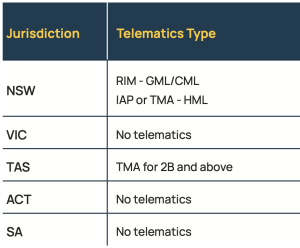
Network Implementation
The NHVR is going to continue to work with state and local government road managers to continue to expand the network covered by the National Class 2 Tier 1 PBS Notice
One of the first additional areas the NHVR is looking at is to provide PBS level 3A vehicles access to the type 1 road train networks. This will offer Road Train operators additional access to and from the networks and areas of operation.
Smedley’s Engineers can assist with all your PBS access and compliance needs and help you gain the most benefit from your existing or proposed new fleet combinations.Contact our PBS specialist consultants today >>
